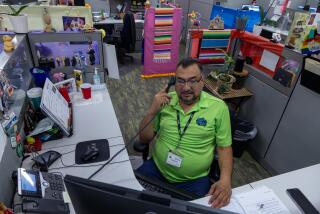Hospital Offers a Prescription for Change : Education: St. Francis Medical Centerâs nurses training program is helping unemployed young people find work--and hope.
Whatâs the Rx for a neighborhood that sometimes seems to be wheezing from social and economic ailments?
In Lynwood, nurses are part of the cure.
A nurses training program at St. Francis Medical Center is turning unemployed young people into medical professionals--and role models--in a community sometimes beset by gang violence and unemployment as high as 14%.
The program, expanded after the 1992 riots, has produced 155 nurses; 90% of them have found jobs at the 50-year-old Imperial Highway hospital.
âIt got me off welfare,â said nurse Geraldine Battle, a mother of two who is now saving to buy her first home.
Blanca Estrella said the 13-month training program forced her to buckle down with her high school studies as well. âIâd probably have dropped out of school if it hadnât been for this,â she said.
The new nurses work throughout the 478-bed hospital. That puts them in position to supply hope along with medical aid to friends from Lynwood and Compton who turn up as patients.
âI tell them there are programs out there to help them make something of their lives,â said Teresa Gomez--who has encountered unmarried high school friends in St. Francisâ maternity ward.
Hospital administrators say they hope to expand the job placement part of the program to 60 Catholic hospitals and clinics.
State officials say the project may be just what the doctor ordered for other communities.
âItâs an innovative and strong programâ that hospitals elsewhere could benefit from trying, said Ann Shuman, supervising nursing education consultant with the stateâs Board of Vocational Nurse and Psychiatric Technician Examiners in Sacramento.
St. Francisâ nurses training program was started in 1988 by Sister Elizabeth Joseph Keaveney, the hospitalâs president. She widened its scope four years later by obtaining a post-riot grant from Rebuild L.A. and seed money from the hospitalâs Thomas and Dorothy Leavey Foundation.
The program grew to include high school seniors in Lynwood and Compton, along with older students from Comptonâs adult school. The applicants were screened for gang ties and students were warned that they would have to maintain passing grades in high school courses while they were in the program.
These days, St. Francis shoulders most of the $10,000 cost of training each student, according to Mary Ann Morison, the hospitalâs vice president of clinical services.
Classroom work and hospital room work are involved.
âYou have to convince them at first that they can do it--maybe they havenât had much motivation in the past,â said Beatrice Taylor, a nurse who is one of the programâs instructors.
âI tell them that when they finish this they are going to become an important person in their community.â
Nurse trainees are not allowed to attempt invasive procedures such as injections or drawing blood without instructorsâ supervision. Most patients are happy to have the young people around.
âOnly occasionally will one say, âI donât want a student practicing on me,â or âI donât want to be a guinea pig,â â Taylor said.
Other staff nurses become mentors for the trainees. Most do not mind sharing nursing stations with newcomers.
âFor some of them this is the first time theyâve ever been in a hospital,â said Darthola Brown, who has worked at St. Francis for 26 years. âI just remember that I was in their shoes once, and that somebody had to put up with me and my questions.â
The training was eye-opening, said Estrella, a 22-year-old Lynwood resident who said she and fellow trainees willingly gave up âall of our social livesâ while they juggled high school work with the medical instruction.
âMy first âcode blueâ was shocking,â she said of the call for doctors and nurses to rush to the bedside of a patient who had stopped breathing.
âIt was our third week of training and we hadnât seen anything like it before. I helped bring the âcrash cartâ with equipment in. We saved the patient. It felt real good.â
But Estrella said she does not feel good when she sees some of her former high school classmates land in the hospital as victims of violence or as unwed mothers.
âItâs sad to see them not doing anything, living their lives on a day-to-day basis, without any goals,â she said.
Gomez, 22, a Lynwood High graduate who lives in Bell Gardens, said she tells former classmates that there are ways to carve out meaningful lives and careers.
âI tell them there are programs out there that can help them like weâve been helped,â she said.
Like most others in the program, Gomez and Estrella were offered $8-per-hour jobs as certified nurse assistants at St. Francis after graduating. Later, after passing a 200-question state test, they can become licensed vocational nurses and earn a starting salary of $12 an hour.
The prospect of steady employment and a career that can lead to an even better-paying job as a registered nurse has resulted in a list of 1,500 applicants for the 70 positions available in each class, according to Marilyn Overby, a nurse who directs St. Francisâ education programs.
She said 90% of the students picked for the program complete it--including a few who need special counseling to prevent them from getting caught up in outside gang or drug activities.
High school students arenât the only ones in the program.
Battle, 34, was a divorced mother of two living on welfare when she signed up for the program in 1992. She worked for a year as a nursing assistant before becoming a licensed vocational nurse last year.
âIâd probably still be sitting at home and still be on welfare if it wasnât for this,â she said as she took a break on St. Francisâ medical-surgical floor. There, she was updating patientsâ charts, giving medication and changing bandages.
Her work has had another positive benefit, Battle said. It has motivated her 15-year-old daughter, Rhyshena.
âNow sheâs looking at a nursing career. Sheâs been accepted at the King/Drew Medical Magnet School,â Battle said.
âThatâs made me very happy.â
More to Read
Sign up for Essential California
The most important California stories and recommendations in your inbox every morning.
You may occasionally receive promotional content from the Los Angeles Times.











